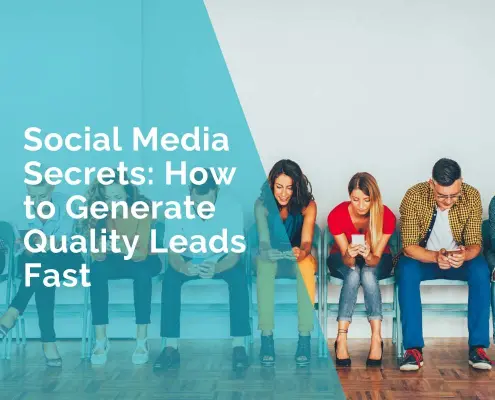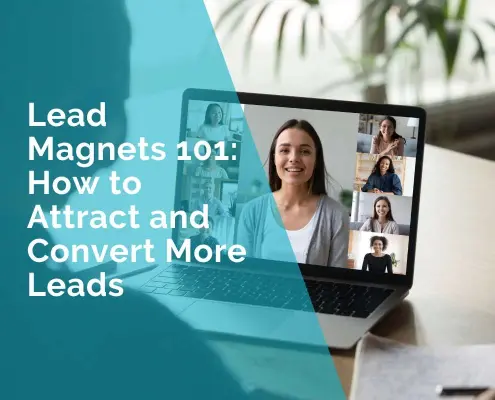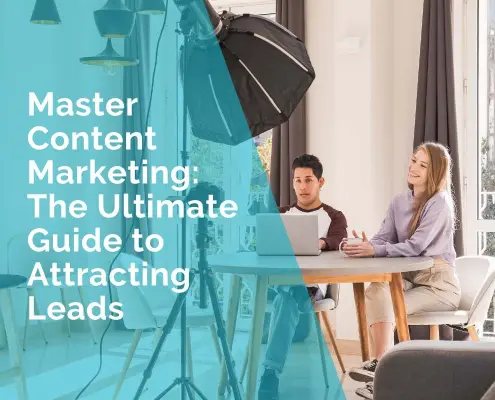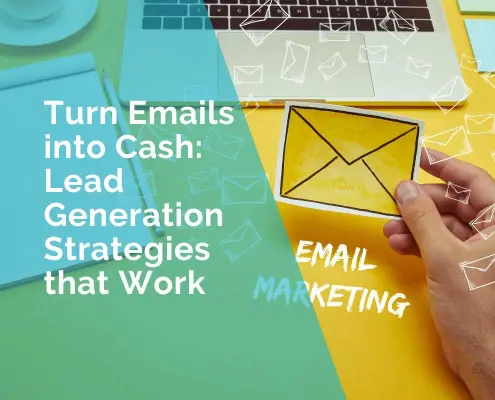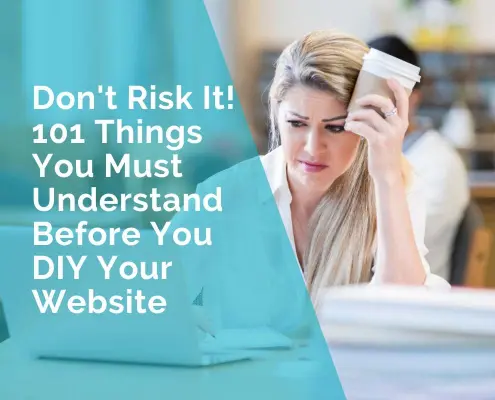Social Media Secrets: How to Generate Leads Fast
Did you know that 73% of marketers believe that social media marketing has been somewhat or very effective for their business? This shows just how powerful social media can be in driving leads and growing your business.
Using social media for lead generation is essential in today’s digital world. It’s not just about getting likes and followers; it’s about turning those engagements into potential customers. Social media allows you to connect with a broader audience, build relationships, and ultimately drive more sales.
Understanding Social Media Lead Generation
Definition
Social media lead generation is the process of using social media platforms to attract and capture potential customers’ interest. This can be done through various methods like engaging content, ads, contests, and more.
Importance
Social media is a powerful tool for generating leads because it allows you to reach a large, targeted audience at a relatively low cost. It provides opportunities to engage with your audience in real-time, build trust, and establish your brand as an authority in your industry. For instance, a local bakery might use Instagram to showcase their delicious products, attracting local followers who could become regular customers.
Platforms Overview
Different social media platforms offer unique benefits for lead generation:
- Facebook: Great for reaching a broad audience. It offers various ad formats and targeting options to help you find your ideal customers. A clothing boutique could use Facebook ads to target women aged 18-35 who are interested in fashion.
- Instagram: Perfect for visual content. Ideal for businesses with strong visual elements like food, fashion, or travel. A fitness trainer might use Instagram to share workout tips and transformation stories, engaging with followers who could sign up for personal training sessions.
- LinkedIn: Best for B2B lead generation. It allows you to connect with professionals and decision-makers in your industry. A marketing consultant could use LinkedIn to share insights and connect with potential clients.
- Twitter: Good for real-time engagement and quick updates. Useful for businesses that need to stay on top of trends and news. A tech startup might use Twitter to announce new product features and engage with tech enthusiasts.
Setting Up Your Social Media Profiles for Success
Optimizing Your Profiles
To make your social media profiles work for you, they need to be eye-catching and professional. Start with a high-quality profile picture and cover photo that represent your brand well. For instance, if you own a bakery, your profile picture could be your logo, and your cover photo might be a mouth-watering image of your best-selling pastries.
Your bio should clearly describe what your business does and include a brief, compelling statement about what makes you special. If you’re a local fitness trainer, your bio might say, “Helping busy professionals get fit with quick and effective workouts!”
Consistent
Branding Consistency in branding helps people recognize your business across different platforms. Use the same logo, colors, and tone of voice on all your social media profiles. If your brand’s color scheme is blue and green, make sure these colors are used in your profile pictures, cover photos, and any graphics you post. This consistency helps build trust and makes your brand easily recognizable.
Contact Information
Make sure your contact information is easy to find. Include a link to your website or online store in your bio, and if possible, add your email address or phone number. For example, a pet grooming business might include a link to their online booking system in their Instagram bio, making it simple for customers to schedule an appointment.
Creating Engaging Content That Converts
Content Types
Different types of content can help you attract leads. For example:
- Blog Posts: Share informative articles related to your industry. A landscaping business might post tips on garden maintenance.
- Videos: Create short videos showing your products or services in action. A hair salon could post tutorials on different hairstyles.
- Infographics: Use visuals to convey information quickly. A nutritionist might create an infographic with healthy eating tips.
- Live Streams: Host live sessions to interact with your audience in real-time. A coffee shop could do a live tour of their roasting process.
Value-Driven Content
Always aim to provide value with your content. This means giving your audience information or entertainment that is useful to them. For example, if you run a travel agency, you might share tips for affordable travel or highlight unique destinations. When your content is valuable, people are more likely to engage with it and view your business as a helpful resource.
Call-to-Actions (CTAs)
CTAs are prompts that encourage your audience to take a specific action, such as signing up for a newsletter or visiting your website. Make sure your CTAs are clear and compelling. For instance, if you offer a free consultation, your CTA might be “Book your free consultation today!” Place CTAs in your posts and stories to guide your audience towards becoming leads.
Leveraging Paid Advertising on Social Media
Benefits of Paid Ads Investing in social media ads can be very helpful for reaching new customers and boosting your business. Unlike organic posts, which rely on followers to see your content, paid ads can put your message in front of a larger audience. For example, a local bakery can use Facebook ads to reach people in their area who might not already follow them. This way, they can attract new customers who see their ads and are tempted by their delicious offerings.
Types of Social Media Ads
There are different types of social media ads you can use to achieve your goals:
- Sponsored Posts: These are regular posts that you pay to boost so more people see them. A clothing store might sponsor a post showing off a new collection.
- Carousel Ads: These allow you to show multiple images or videos in one ad that users can swipe through. A travel agency might use carousel ads to showcase various vacation packages.
- Video Ads: These ads use video content to grab attention. A fitness coach could create a video ad demonstrating workout routines and share it on Instagram.
Targeting and Retargeting
Social media ads can be targeted to reach specific groups of people based on their interests, age, location, and more. This means you can make sure your ads are shown to people who are likely to be interested in your products or services. For example, if you sell handmade jewelry, you can target people who have shown interest in fashion or accessories.
Retargeting is another important feature. It lets you show ads to people who have visited your website but didn’t make a purchase. For instance, if someone browses your online store but leaves without buying, retargeting ads can remind them of what they left behind and encourage them to return.
Engaging with Your Audience
Responding to Comments and Messages
Engaging with your audience is crucial for building relationships and trust. When people comment on your posts or send you messages, make sure to respond promptly and thoughtfully. For example, if a customer leaves a positive review on your restaurant’s Facebook page, thank them for their feedback. If someone asks a question about your services, provide a helpful answer. This interaction can make your audience feel valued and more likely to become loyal customers.
Hosting Q&A Sessions and Webinars
Interactive formats like Q&A sessions and webinars can be very effective for attracting and nurturing leads. You can host a live Q&A on Instagram to answer questions about your products or services. For instance, a real estate agent might host a live session to give tips on buying a home. Webinars are also useful for providing more in-depth information on a topic. A digital marketing agency could host a webinar on SEO strategies to draw in potential clients.
User-Generated Content
Encouraging your audience to create and share content related to your brand can be a powerful way to build engagement. You might run a contest asking customers to post photos of themselves using your products, or ask them to share their experiences with your services. For example, a coffee shop could encourage customers to post their favorite coffee drink and tag the shop in their posts. This not only promotes your business but also helps you connect with your audience on a more personal level.
“Social media is a goldmine for leads when you focus on building trust and delivering value to your audience.“
Ivana Katz
Utilizing Social Media Tools and Analytics
Social Media Management Tools
Social media management tools help you schedule posts and keep track of your engagement across different platforms. These tools can save you time and make your social media efforts more organized. For example:
- Hootsuite: This tool lets you plan posts for various social media sites and monitor how your content is performing.
- Buffer: Similar to Hootsuite, Buffer helps you schedule posts and analyze their effectiveness.
- Canva: While not a management tool per se, Canva is great for creating visually appealing posts and graphics for your social media.
Analytics
Tracking your performance on social media is important to understand what’s working and what’s not. Analytics tools can help you see how many people are engaging with your posts, how often they’re interacting, and which types of content are most popular. For example:
- Facebook Insights: Shows you how your posts are performing on Facebook, including likes, shares, and comments.
- Instagram Analytics: Provides data on how your Instagram posts and stories are doing, including how many people saw them and how they interacted.
- Twitter Analytics: Helps you see how your tweets are performing, including the number of impressions and engagement rates.
Adjusting Strategies
Using the data from these analytics tools, you can make changes to your social media strategies to get better results. For instance, if you notice that video posts get more engagement than photos, you might decide to create more videos. Or if certain types of content are not performing well, you can adjust your approach based on what you’ve learned.
Building Partnerships and Collaborations
Influencer Marketing
Collaborating with influencers can help you reach a larger audience. Influencers are people who have a strong following on social media and can help promote your business to their audience. For example, a small clothing boutique might work with a fashion blogger who has many followers. The blogger could wear the boutique’s clothes and share their experience, which can attract their followers to check out the boutique.
Cross-Promotions
Partnering with other businesses can be a great way to share audiences and create new content. For example, a local gym might team up with a health food café to offer joint promotions. They could share each other’s posts and create content together, like a video showing a workout followed by a healthy meal.
Guest Posts and Takeovers
Allowing others to create content for your social media and vice versa can help you reach new people. For example, a travel agency might invite a popular travel blogger to write a guest post on their blog. Similarly, you could do a “social media takeover” where an influencer posts on your account for a day. This can introduce their audience to your business and give your content a fresh perspective.
Overcoming Common Challenges
Dealing with Low Engagement
If your social media posts aren’t getting much interaction, there are a few things you can try to boost engagement. First, ensure your content is interesting and relevant to your audience. For example, a local bakery might share recipes or behind-the-scenes videos of how their cakes are made, which can be more engaging than just posting pictures of finished products. You can also ask questions in your posts to encourage people to comment. Running a poll or a giveaway can also attract more interaction.
Managing Negative Feedback
Negative comments or reviews can be tough, but they offer a chance to show good customer service. Respond politely and professionally to any criticism. For example, if someone complains about slow service at your café, thank them for their feedback and explain how you’re working to improve. This shows other customers that you care and are willing to make things right. Handling negative feedback well can actually improve your reputation and build trust with your audience.
Staying Updated
Social media trends and platform algorithms change often. To stay ahead, follow industry news and updates from the social media platforms you use. For example, if Instagram introduces a new feature, learning how to use it early can give you an edge. Joining social media groups or forums can also help you keep up with trends and share tips with other business owners.
Don’t be afraid to try new strategies and see what works best for your business. Social media can be a powerful tool for connecting with potential customers and growing your business.
Resources and Tools
Tools
- Hootsuite – Social media management and scheduling.
- Buffer – Social media scheduling and analytics.
- Sprout Social – Social media management and analytics.
- Canva – Design tool for creating engaging social media visuals.
- Google Analytics – Tracks website traffic from social media.
- Facebook Ads Manager – Manages and tracks Facebook and Instagram ads.
- LinkedIn Ads – Manages LinkedIn advertising campaigns.
- Twitter Ads – Manages and tracks Twitter advertising.
- CoSchedule – Content calendar and social media scheduling.
- BuzzSumo – Analyzes content performance and trends.
Books
- “Jab, Jab, Jab, Right Hook: How to Tell Your Story in a Noisy Social World” by Gary Vaynerchuk – Strategies for social media marketing.
- “Social Media Marketing for Dummies” by Shivangi Narula and others – A guide for beginners to advanced social media marketing.
- “Building a StoryBrand: Clarify Your Message So Customers Will Listen” by Donald Miller – Crafting compelling messages for social media.
Podcasts
- “Social Media Examiner – Social Media Marketing Podcast” – Insights and tips from industry experts.
- “Marketing Over Coffee” – Marketing advice including social media strategies.
- “Online Marketing Made Easy with Amy Porterfield” – Tips on digital marketing including social media.
Blogs & Websites
- Social Media Examiner – Latest news and tips on social media marketing.
- HubSpot Blog – Social media marketing advice and strategies.
- Neil Patel Blog – Insights on digital marketing and social media tactics.
- Buffer Blog – Tips and case studies on social media marketing.
- Sprout Social Blog – Best practices and trends in social media marketing.
Frequently Asked Questions
What is lead generation on social media?
Lead generation on social media involves using social platforms to attract and capture potential customers’ information. This could be through engaging content, ads, or interactive posts that encourage users to provide their contact details or sign up for more information. For instance, a fitness trainer might run a campaign offering a free workout plan in exchange for an email address.
How can I use Facebook to generate leads?
Facebook offers several tools for lead generation, such as Facebook Ads, which allow you to target specific audiences with sponsored posts and lead ads. Lead ads are particularly useful because they include a form within the ad itself, making it easy for users to sign up or request more information without leaving Facebook. A local restaurant might use lead ads to offer a free meal voucher in exchange for an email signup.
What types of content are best for generating leads on Instagram?
On Instagram, visually appealing content such as high-quality images, videos, and stories work well. Use these formats to showcase your products or services and include calls-to-action (CTAs) like “Swipe up” links or “Click the link in bio” for lead capture. For example, a beauty brand could post tutorial videos with a link to sign up for exclusive beauty tips.
How can LinkedIn be used for lead generation?
LinkedIn is great for B2B lead generation. You can use it to connect with industry professionals, share valuable content, and join relevant groups. LinkedIn’s sponsored content and InMail ads allow you to reach decision-makers directly. A software company might share industry insights and use InMail to offer free demos to key prospects.
How do I create effective social media ads for lead generation?
To create effective social media ads, ensure your ad has a clear and compelling message, a strong CTA, and is visually appealing. Target your ads based on demographics, interests, and behaviors to reach your ideal audience. For example, a travel agency might run a targeted ad offering a free travel guide to people interested in vacation destinations.
How can I use social media contests for lead generation?
Social media contests can drive engagement and collect leads if designed effectively. Require participants to enter their contact information to participate, and offer a valuable prize related to your business. For example, a clothing brand might host a giveaway where participants must enter their email to win a shopping spree.
What role do hashtags play in social media lead generation?
Hashtags help increase the visibility of your posts to a broader audience interested in specific topics. Use relevant and trending hashtags to reach users who might be interested in your products or services. For instance, a fitness coach might use hashtags like #FitnessTips or #HealthyLiving to attract health-conscious individuals.
How often should I post on social media to generate leads?
Consistency is key. Aim to post regularly, such as a few times a week, to keep your audience engaged and attract new leads. The exact frequency can depend on your industry and platform. For example, a real estate agent might post property listings and market insights several times a week to stay top-of-mind.
 Ivana Katz from Websites 4 Small Business is an award winning web designer who builds websites that build your business. She provides unbeatable web design services to fit your budget.
Ivana Katz from Websites 4 Small Business is an award winning web designer who builds websites that build your business. She provides unbeatable web design services to fit your budget.
The end result? Professional, custom-made sites that give your business the extra oomph it needs to stand out from the competition and make an impact.
Whether you’re a brand-new business or an established one ready to improve your digital presence, Ivana makes it easy to get your business online very quickly. Her websites are professional, tailored to fit your budget, and give your business a serious boost.
Download your FREE copy of “Ultimate Website Design Secrets Blackbook – 10 Bulletproof Strategies for Designing an Outrageously Successful Website”



